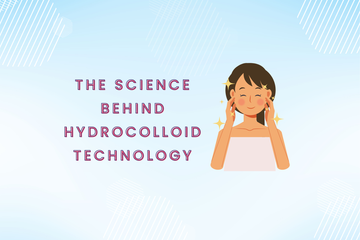Hydrocolloid technology has become a buzzword in modern skincare, especially in acne treatment. But behind its popularity lies real science. Whether it’s healing pimples or promoting faster skin recovery, hydrocolloid patches are backed by decades of medical research. This article dives deep into the science behind hydrocolloid technology, exploring its applications in acne care, wound healing, and maintaining moisture balance in skincare.
Let’s explore how this simple yet effective innovation works and why it’s trusted in both medical and cosmetic treatments.
What Is Hydrocolloid Technology?
Hydrocolloid technology refers to a type of dressing or patch made of gel-forming agents like pectin, gelatin, or carboxymethylcellulose. These agents are embedded in a flexible material that forms a soft, self-adhesive layer when applied to the skin. It works by interacting with moisture and wound exudate to create a gel-like environment that promotes healing.
Originally developed for medical purposes, especially for wound treatment, hydrocolloid is now widely used in skincare products, particularly for pimple patches. It forms the foundation of many skin healing products available today.
How Hydrocolloid Patches Work
To understand how hydrocolloid patches work, think of them as a protective layer that draws out fluid while keeping the area moist. When applied to a wound or pimple, the patch absorbs exudate (fluid or pus), which helps flatten the blemish and accelerate healing. The patch swells slightly and turns white as it absorbs impurities.
This sealed environment prevents external bacteria from entering while encouraging internal repair. It keeps the affected area clean, hydrated, and protected from further irritation or contamination.
The Scientific Basis of Pimple Patches
The scientific basis of pimple patches is grounded in the body’s natural healing process. When skin is injured or inflamed, maintaining a moist environment has been shown to improve cell regeneration. Hydrocolloid dressings mimic this ideal healing condition.
By pulling out pus and debris from acne lesions, these patches help reduce inflammation and size overnight. Unlike creams or ointments, hydrocolloid patches don’t introduce active chemicals into the skin—they simply assist in physical healing. This makes them ideal for sensitive skin or people who prefer minimalist treatment approaches.
Wound Healing with Hydrocolloid
Hydrocolloid technology was first used in hospitals for wound healing, especially in burns, ulcers, and surgical recovery. These patches promote healing by creating a barrier that keeps wounds moist and insulated from contaminants.
The gel created under the patch allows skin cells to move across the wound more efficiently, speeding up tissue repair. It also reduces pain by covering nerve endings and protecting the wound from friction. Because of this success, hydrocolloid was adapted into acne and hydrocolloid skincare formats.
The same principles that apply to a surgical wound can be applied to inflamed or popped pimples—making hydrocolloid patches a form of medical-grade skincare.
Additionally Managing menstrual discomfort can be a challenge, but you don’t have to face it alone. The Matri Period Pain Relief Device is here to support you every step of the way. This innovative device is engineered to specifically target and ease menstrual cramps, seamlessly fitting into your daily self-care and hygiene routines.
We’re excited to announce the arrival of our latest product innovations, as highlighted in our recent press release. Our newest launches bring groundbreaking features and unmatched value, all designed to elevate your comfort and cater to your evolving needs.
Role of Moisture Balance in Skincare
One of the most important aspects of healthy skin is maintaining optimal hydration. Moisture balance in skincare is crucial for healing, comfort, and appearance. When the skin is too dry, it cracks and slows healing. When too wet, it becomes prone to bacterial infections.
Hydrocolloid patches help strike the right balance. They keep the skin hydrated without over-saturating it. This helps preserve the skin barrier and reduces the chances of scabbing, peeling, or scarring. It’s a reason why hydrocolloid is now used not just for acne but also for treating blisters, minor cuts, and burns.
Hydrocolloid Patch Science vs. Traditional Treatments
Compared to traditional spot treatments like creams and gels, hydrocolloid patches provide a unique, non-invasive method. Traditional acne products often rely on harsh chemicals such as benzoyl peroxide or salicylic acid. While effective, these can cause irritation, dryness, or peeling—especially for sensitive skin.
Hydrocolloid patch science relies on a gentle, supportive mechanism. It doesn’t attack the pimple; it supports your skin in removing debris naturally. This makes hydrocolloid a preferred solution for people who want to avoid harsh side effects or are dealing with occasional breakouts.
Who Should Use Hydrocolloid Patches?
Hydrocolloid patches are best for those dealing with surface-level acne like whiteheads or early-stage pimples. They’re not meant for deep, cystic acne but can still help cover and protect those areas to prevent picking or further irritation.
People with sensitive skin, teens, or adults prone to occasional breakouts can benefit greatly. If used after a pimple has popped or burst, it can also absorb leftover fluid and protect the skin during recovery. It’s a practical solution for those who want effective, minimal, and fuss-free skincare.
Common Myths About Hydrocolloid Technology
One common myth is that hydrocolloid patches contain medications. Most do not. Their effectiveness comes from their ability to absorb and shield—not medicate. Another myth is that they work instantly. While many users see overnight improvements, the patch needs a few hours to work effectively.
People also assume they can be used on all acne types. While helpful for most surface pimples, they are less useful for blackheads or deeper nodules unless combined with active ingredients or microneedle technology.
Are Hydrocolloid Patches Safe?
Yes, hydrocolloid patches are generally very safe. Since they don’t involve chemical treatment, the risk of allergic reaction is low. However, those with very sensitive skin should always check for any adhesives in the patch that could cause irritation.
The key to safety lies in using them on clean skin and not applying them to infected or open wounds that require medical attention. Always follow product instructions and avoid using expired patches.
Conclusion
Hydrocolloid technology has transformed from a medical-grade wound dressing into an accessible and effective skincare tool. By leveraging the body’s own healing process, hydrocolloid patches provide gentle and targeted care for acne, minor wounds, and skin irritation. Their ability to maintain moisture balance in skincare, absorb fluid, and protect the skin makes them a trusted part of both clinical and cosmetic care routines.
Whether you’re dealing with a breakout or healing a small cut, understanding the science behind hydrocolloid technology helps you make smarter, skin-friendly choices.
FAQs
1. What is hydrocolloid technology made of?
Hydrocolloid technology uses materials like gelatin, pectin, and carboxymethylcellulose. These form a moisture-absorbing gel that helps draw out fluids from wounds or pimples while protecting the skin from external irritants.
2. How do hydrocolloid patches help with acne?
They absorb pus and oil from pimples, reduce swelling, and create a moist environment for faster healing. They also prevent you from touching or picking at your acne, reducing the chance of scarring.
3. Can hydrocolloid patches be used every day?
Yes, they can be used daily if needed. However, they are best applied only when a visible pimple is present, and you should replace the patch every 6–8 hours or as directed by the brand.
4. Do hydrocolloid patches contain medication?
No. Most hydrocolloid patches are non-medicated. They work by physically absorbing fluid from the skin. Some versions may contain added ingredients, but basic patches rely purely on the hydrocolloid action.
5. Is hydrocolloid safe for sensitive skin?
Yes. Hydrocolloid is generally safe for sensitive skin because it does not include active chemicals. However, check for adhesive reactions and discontinue use if irritation occurs.
6. Can hydrocolloid help with wound healing?
Yes. Hydrocolloid dressings are commonly used in hospitals for treating wounds like ulcers, burns, and blisters. They promote faster healing by keeping the wound moist and protected.
7. Are hydrocolloid patches better than creams?
For certain types of pimples, yes. They offer a targeted, mess-free solution without causing dryness or irritation that can occur with chemical creams. They are ideal for overnight spot treatment.
8. How long does it take to see results with hydrocolloid patches?
Most users see visible flattening or reduction in a pimple within 6 to 8 hours. For deeper acne, multiple applications may be needed over a couple of days.
9. Can hydrocolloid be used under makeup?
Yes. Many hydrocolloid patches are designed to be thin and clear, making them suitable under makeup. They act as a barrier while still allowing for cosmetic application.
10. Are there any side effects of hydrocolloid patches
Side effects are rare. In some cases, users may experience minor redness from the adhesive. Always apply to clean skin and avoid use on infected or broken wounds needing medical attention.







hch8iw
2m7m1y
m9m10r
uvq1qq
uvq1qq